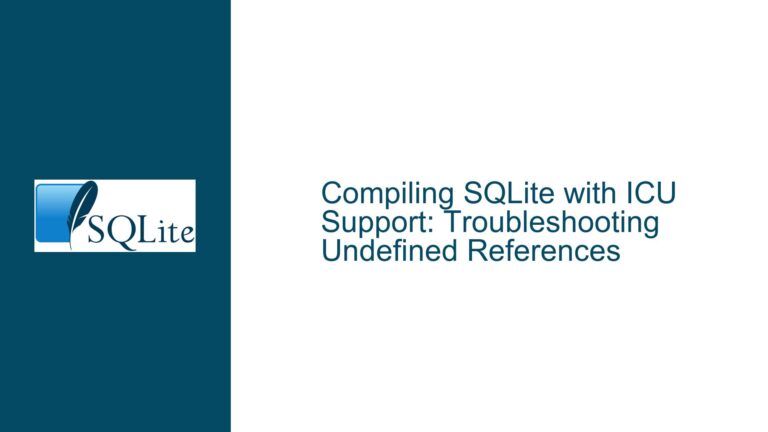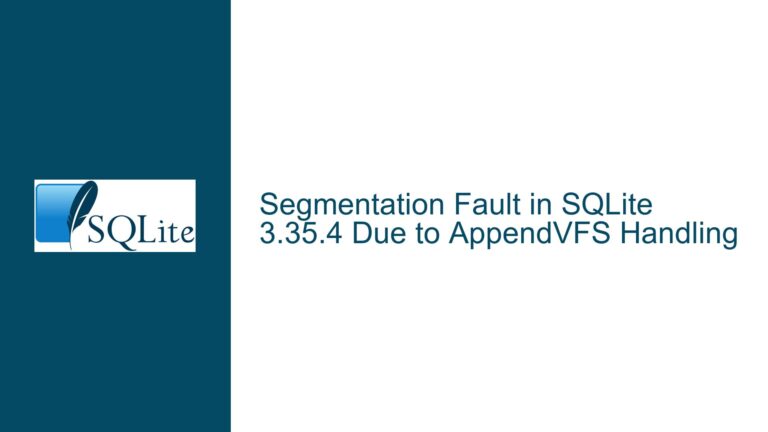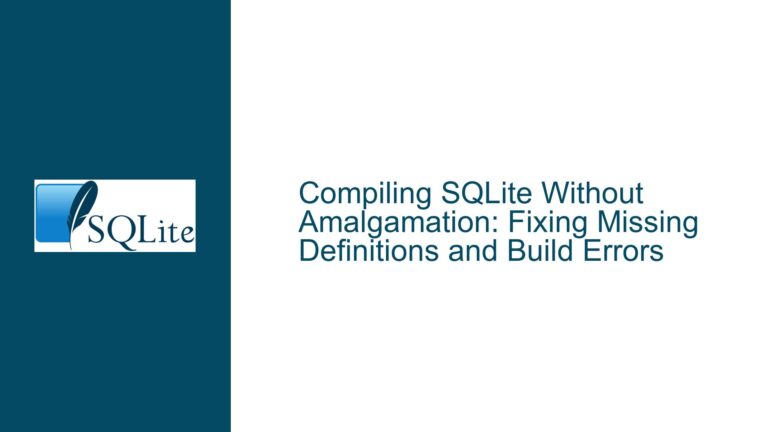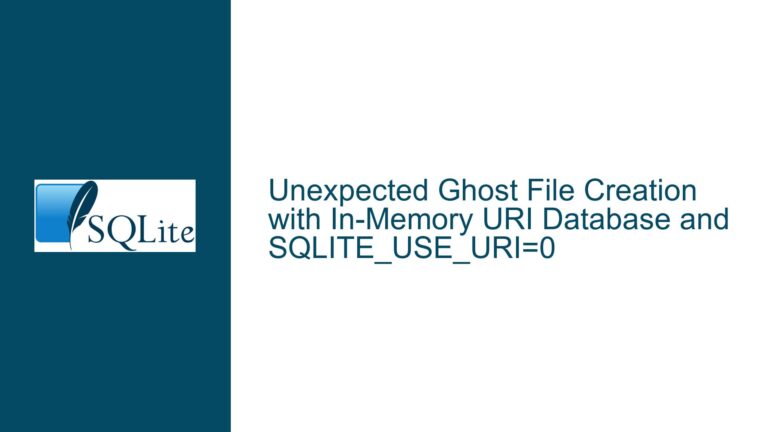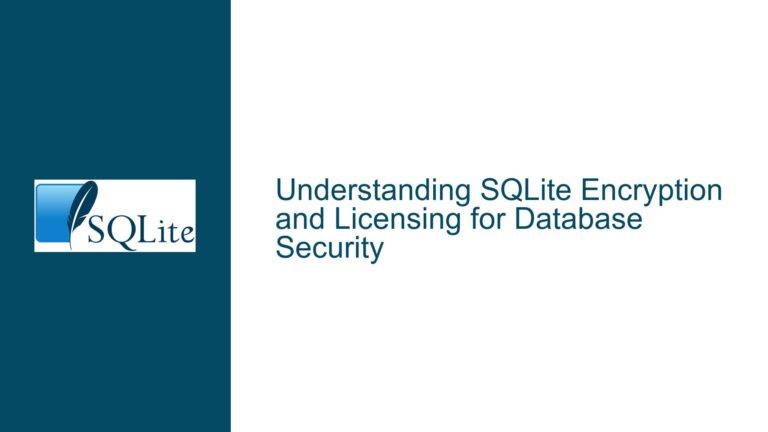SQLite Documentation and Pragmas for Table Metadata Access
Navigating SQLite Documentation and Pragmas for Table Metadata
SQLite is a powerful, lightweight, and widely-used relational database management system. However, its documentation, while comprehensive, can sometimes be challenging to navigate, especially for users seeking specific functionalities like accessing table metadata. This post will delve into the nuances of SQLite’s documentation structure, the use of pragmas for table metadata, and how to effectively find and utilize the information you need.
Issue Overview: Accessing Table Metadata via pragma_table_info
One of the core issues discussed revolves around accessing table metadata, specifically column definitions, in a selectable format. The user initially struggled to find documentation on pragma_table_info, a pragma function in SQLite that provides detailed information about the columns of a table. This pragma is particularly useful for dynamically retrieving column names, types, and other attributes, which can be crucial for database introspection and dynamic query generation.
The confusion stemmed from the documentation’s organization, where pragma_table_info is not immediately obvious. Instead, the documentation is divided into various sections, each focusing on different aspects of SQLite, such as SQL syntax, C API, and pragmas. The user’s expectation was a single, unified overview document that would cover all these aspects in a linear fashion, which is not the current structure of SQLite’s documentation.
Possible Causes: Documentation Structure and Discoverability
The primary cause of the user’s difficulty lies in the structure and discoverability of SQLite’s documentation. SQLite’s documentation is reference-oriented, meaning it is designed to provide detailed information on specific topics rather than offering a narrative or tutorial-style guide. This approach is beneficial for users who already have a foundational understanding of SQL and database concepts but can be daunting for those who are new or looking for a more guided introduction.
The documentation is organized into several key sections:
SQL Syntax: This section covers the SQL commands and syntax supported by SQLite. It includes detailed explanations of commands like
SELECT,INSERT,UPDATE, andDELETE, as well as more advanced topics like triggers, views, and transactions.C API: This section is aimed at developers who are integrating SQLite into applications written in C or C++. It provides detailed information on the functions and data structures available in the SQLite C API.
Pragmas: Pragmas are special commands in SQLite that are used to modify the operation of the SQLite library or to query the database for internal state information. The
pragma_table_infois one such pragma, and it falls under this category.Miscellaneous: This includes various other topics like file format, virtual tables, and extensions.
The challenge arises because these sections are somewhat siloed, and there is no single document that ties everything together in a narrative format. Additionally, the search functionality on the SQLite documentation page may not always yield the expected results, especially for less commonly used features like pragma_table_info.
Troubleshooting Steps, Solutions & Fixes: Effective Navigation and Utilization of SQLite Documentation
To effectively navigate and utilize SQLite’s documentation, especially when dealing with specific functionalities like pragma_table_info, the following steps and strategies can be employed:
Understanding the Documentation Structure: The first step is to familiarize yourself with the overall structure of SQLite’s documentation. The home page (https://www.sqlite.org/index.html) serves as a table of contents, providing links to the main sections. Understanding where to look for specific information is crucial. For example, if you’re looking for SQL syntax, you would navigate to the "SQL Syntax" section, whereas for pragmas, you would look under the "Pragmas" section.
Using the Keyword Index: SQLite provides a keyword index (https://sqlite.org/keyword_index.html) that can be incredibly useful for finding specific terms or functions. If you’re looking for
pragma_table_info, searching the keyword index would lead you to the relevant documentation. This index is particularly helpful when the main search function on the documentation page does not yield the desired results.Exploring the Pragmas Section: Since
pragma_table_infois a pragma, it is documented under the "Pragmas" section of the SQLite documentation. The pragmas section provides detailed information on all the pragmas supported by SQLite, including their syntax and usage. Forpragma_table_info, the documentation explains that it can be used to retrieve information about the columns of a table, including the column name, data type, whether it can be NULL, and whether it is part of the primary key.Leveraging the C API Documentation: If you’re working with SQLite in a C or C++ environment, the C API documentation (https://sqlite.org/c3ref/intro.html) is an invaluable resource. It provides detailed information on how to use SQLite’s C API to interact with the database programmatically. While this may not be directly relevant to using
pragma_table_infoin SQL queries, it is essential for understanding how SQLite operates at a lower level.Consulting External Resources: While SQLite’s official documentation is comprehensive, it may not always provide the level of detail or examples that some users need. In such cases, consulting external resources like books, tutorials, and forums can be beneficial. For example, the book "Using SQLite" by Jay Kreibich provides a more narrative and example-driven approach to learning SQLite, which can complement the reference-style documentation provided by SQLite.
Experimenting with the SQLite Shell: The SQLite shell (https://sqlite.org/cli.html) is a command-line tool that allows you to interact with SQLite databases directly. It can be an excellent way to experiment with SQL commands and pragmas like
pragma_table_infoin a controlled environment. By running commands directly in the shell, you can quickly see the results and better understand how different commands and pragmas work.Understanding the Context of Pragmas: Pragmas in SQLite are special commands that are used to modify the operation of the SQLite library or to query the database for internal state information. They are not part of the standard SQL syntax but are specific to SQLite. Understanding this context is crucial for effectively using pragmas like
pragma_table_info. It’s also important to note that pragmas can be used in both SQL statements and the SQLite shell, making them versatile tools for database management.Exploring the SQL Syntax Documentation: While the focus of this post is on
pragma_table_info, it’s worth noting that the SQL syntax documentation (https://sqlite.org/lang.html) is a critical resource for anyone working with SQLite. It provides detailed information on all the SQL commands supported by SQLite, including their syntax and usage. Even if you’re primarily interested in pragmas, having a solid understanding of SQL syntax is essential for effectively working with SQLite.Utilizing the SQLite Forum: The SQLite forum (https://sqlite.org/forum/forum) is an excellent resource for getting help and advice from other SQLite users and developers. If you’re struggling to find information in the documentation or have specific questions about using
pragma_table_infoor other features, the forum can be a valuable resource. Many experienced SQLite users and developers frequent the forum and are often willing to help with questions and issues.Staying Updated with SQLite Releases: SQLite is actively developed, and new features and improvements are regularly added. Staying updated with the latest releases and reading the release notes (https://sqlite.org/changes.html) can help you stay informed about new features and changes that may affect your use of SQLite. This is particularly important if you’re relying on specific features or behaviors that may change between versions.
In conclusion, while SQLite’s documentation may not provide a single, unified overview document, it is a comprehensive and detailed resource for understanding and utilizing SQLite’s features. By familiarizing yourself with the documentation’s structure, using the keyword index, exploring the pragmas section, and leveraging external resources, you can effectively navigate the documentation and find the information you need. Additionally, experimenting with the SQLite shell, understanding the context of pragmas, and staying updated with SQLite releases can further enhance your ability to work with SQLite and access table metadata using pragma_table_info.

